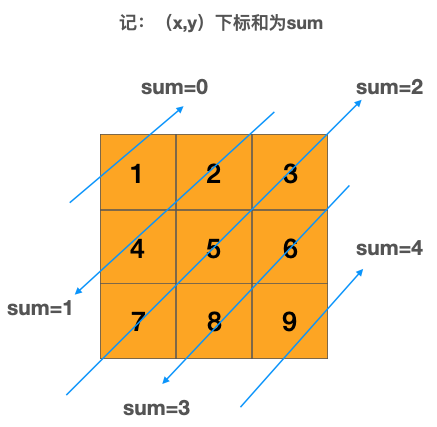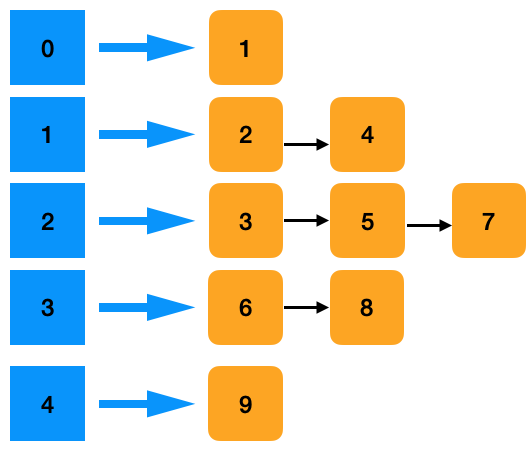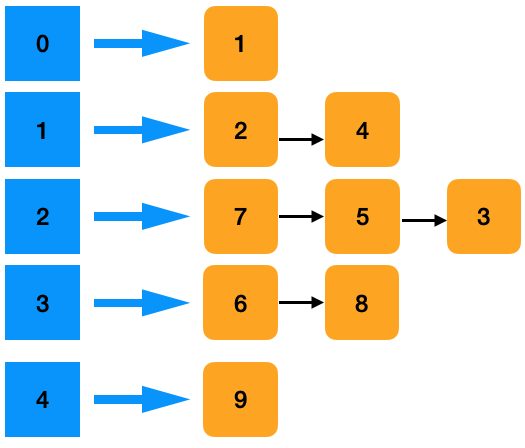题目描述
给你一个大小为 m x n 的矩阵 mat ,请以对角线遍历的顺序,用一个数组返回这个矩阵中的所有元素。
示例 1:
输入:mat = [[1,2,3],[4,5,6],[7,8,9]]
输出:[1,2,4,7,5,3,6,8,9]
示例 2:
输入:mat = [[1,2],[3,4]]
输出:[1,2,3,4]
提示:
m == mat.length
n == mat[i].length
1 <= m, n <= 104
1 <= m * n <= 104
-105 <= mat[i][j] <= 105
解题思路
解法一
1.思路:
把下标和相同的放到同一个链表,然后反转和为偶数的链表。

2.优缺点:
不需要判断方向,不需要模拟,不需要判断边界,不需要推导公式。此方法可以很容易在面试的时候写出来。
缺点是使用了额外空间。
3.举例:
3.1 第一步:对于每个和,添加对应数字到链表
[0] -> [1]
[1] -> [2,4]
[2] -> [3,5,7]
[3] -> [6,8]
[4] -> [9]

3.2 第二步,反转
[0] -> [1]
[1] -> [2,4]
[2] -> [7,5,3]
[3] -> [6,8]
[4] -> [9]

3.3 输出
解法二
定义四个方向,每一步都判段是否越界,越界的话就掉头。需要定义如下关键变量
int m = mat.length;
int n = mat[0].length;
int result[] = new int[m * n];
int i = 0, j = 0;
int dirct[][] = new int[][] { { 0, 1 }, { 1, -1 }, { 1, 0 }, { -1, 1 } };
boolean forword = true;
boolean change = false;
result[0] = mat[0][0];
代码实现
解法一
/**
Ideas:
We just consider the sum of index (i,j).
Add each element of sum to map, and then we need to reverse list.
Time: O(M*N)
Space O(M*N)
*/
class Solution {
public int[] findDiagonalOrder(int[][] mat) {
if(mat == null || mat.length == 0) {
return new int[0];
}
int rows = mat.length;
int cols = mat[0].length;
int[] res = new int[rows*cols];
HashMap<Integer, ArrayList<Integer>> map = new HashMap<>();
// add element to map
for(int i = 0;i < rows;i++) {
for(int j = 0;j < cols;j++) {
int sum = i+j;
if(!map.containsKey(sum)) {
map.put(sum, new ArrayList<>());
}
map.get(sum).add(mat[i][j]);
}
}
// add to res
int idx = 0;
for(Map.Entry<Integer, ArrayList<Integer>> entry: map.entrySet()) {
int sum = entry.getKey();
ArrayList<Integer> list = entry.getValue();
if(sum % 2 == 0) {
// need to reverse
Collections.reverse(list);
}
// add to res
for(int i = 0;i < list.size();i++,idx++) {
res[idx] = list.get(i);
}
}
return res;
}
}解法二
public int[] findDiagonalOrder(int[][] mat) {
int m = mat.length;
int n = mat[0].length;
int result[] = new int[m * n];
int i = 0, j = 0;
int dirct[][] = new int[][] { { 0, 1 }, { 1, -1 }, { 1, 0 }, { -1, 1 } };
boolean forword = true;
boolean change = false;
result[0] = mat[0][0];
for (int k = 1; k < m * n; k++) {
//从左下到右上对接线的遍历
if (forword) {
int newi = i + dirct[3][0];
int newj = j + dirct[3][1];
change = false;
//越界了要改变方向,同时"转弯",优先考虑往(0,1)方向移动
if (outRange(newi, newj, m, n)) {
newi = i + dirct[0][0];
newj = j + dirct[0][1];
change = true;
//存在另一种"转弯"可能
if (outRange(newi, newj, m, n)) {
newi = i + dirct[2][0];
newj = j + dirct[2][1];
}
}
i = newi;
j = newj;
}
//从左下到左对接线的遍历
if (!forword) {
int newi = i + dirct[1][0];
int newj = j + dirct[1][1];
change = false;
//越界了要改变方向,同时"转弯",优先考虑往(1,0)方向移动
if (outRange(newi, newj, m, n)) {
newi = i + dirct[2][0];
newj = j + dirct[2][1];
change = true;
if (outRange(newi, newj, m, n)) {
newi = i + dirct[0][0];
newj = j + dirct[0][1];
}
}
i = newi;
j = newj;
}
if (change) {
forword = !forword;
}
result[k] = mat[i][j];
}
return result;
}
private boolean outRange(int i, int j, int m, int n) {
if (i < 0 || i > m - 1 || j < 0 || j > n - 1) {
return true;
}
return false;
}
解题总结
寻找规律,建议自己不看题解从头到尾实现一遍,不同的人写的会有差异。